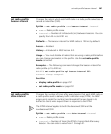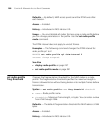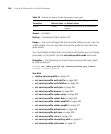
292 CHAPTER 9: MANAGED ACCESS POINT COMMANDS
Use this command without the mode enable or mode disable
option to create a new profile.
mode enable — Enables the radios that use this profile.
mode disable — Disables the radios that use this profile.
Defaults — Each radio profile that you create has a set of properties with
factory default values that you can change with the other set
radio-profile commands in this chapter. Table 57 lists the parameters
controlled by a radio profile and their default values.
Table 57 Defaults for Radio Profile Parameters
Parameter Default Value
Radio Behavior When Parameter Set to
Default Value
11g-only disable Allows associations with 802.11g and
802.11b clients.
Note: This parameter applies only to
802.11b/g radios.
auto-tune enable Allows dynamic configuration of channel
and power settings by MSS.
beacon-interval 100 Waits 100 ms between beacons.
dtim-interval 1 Sends the delivery traffic indication map
(DTIM) after every beacon.
frag-threshold 2346 Transmits frames up to 2346 bytes long
without fragmentation.
long-retry 5 Sends a long unicast frame up to five times
without acknowledgment.
max-rx-lifetime 2000 Allows a received frame to stay in the
buffer for up to 2000 ms (2 seconds).
max-tx-lifetime 2000 Allows a frame that is scheduled for
transmission to stay in the buffer for up to
2000 ms (2 seconds).
preamble-length short Advertises support for short 802.11b
preambles, accepts either short or long
802.11b preambles, and generates unicast
frames with the preamble length specified
by the client.
Note: This parameter applies only to
802.11b/g radios.


















